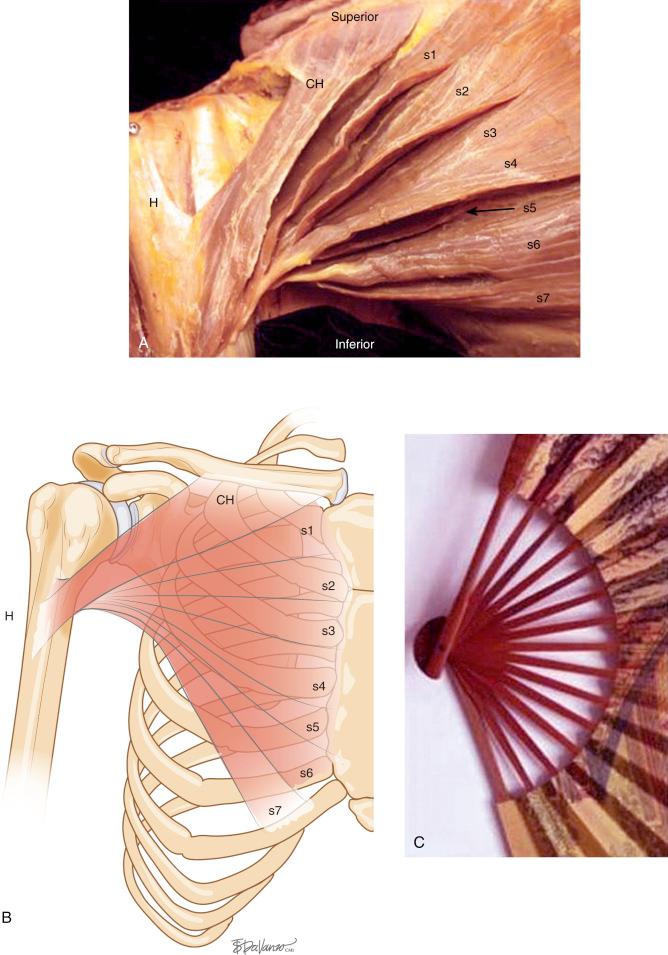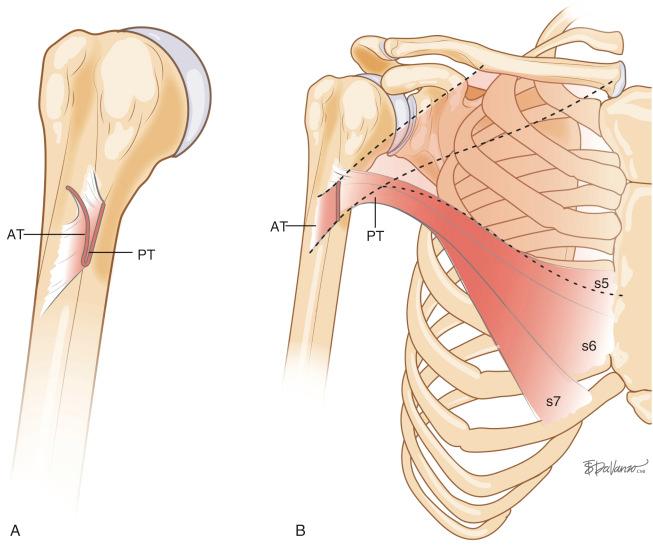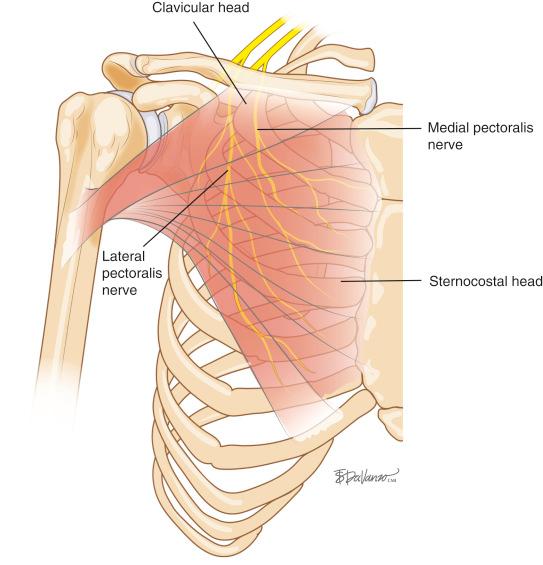Physical Address
304 North Cardinal St.
Dorchester Center, MA 02124
Injuries to the pectoralis major (PM) occur infrequently, typically in young male athletes ( ).
This injury most often develops during high loads, with the arm extended, abducted, and externally rotated, while transitioning from eccentric to concentric contractions of the PM ( ).
Although some of these injuries can be successfully treated nonoperatively, rupture of the tendon can result in significant functional deficits limiting high level athletics.
An accurate and timely diagnosis is of paramount importance in order to achieve definitive treatment and the best possible outcomes after surgical repair ( ).
This chapter first reviews the anatomy of the PM and then discusses the epidemiology, classification, clinical assessment, and advanced imaging modalities for injuries of the PM.
The musculotendinous anatomy of the PM is complex and can be misinterpreted ( ). The PM consists mainly of two heads (the clavicular head and sternocostal head) with a broad origin, which insert as a bilaminar conjoined tendon along the lateral lip of the bicipital grove ( ). The clavicular head originates from the medial and middle third of the clavicle and courses parallel essentially as a uniform structure that forms the vast majority of the anterior tendon lamina, which then inserts more distally ( ). The sternocostal head originates from the sternum and the costal cartilage of the first six ribs. This muscle unit can be divided into six or seven segments, with the inferior segments attaching to the fascia of the external oblique muscles and inserting proximally through the posterior tendon lamina ( ). The orientation of the PM heads has been described as a Asian fan where each superior and inferior adjacent segment overlaps at the musculotendinous junction and inserts into a bilaminar tendon that fuses laterally and attaches to the humerus ( ) ( Fig. 20.1 ).

The tendon of the PM, from the myotendinous junction to the humeral insertion, can measure 5 to 15 mm medial to lateral ( ). The overall tendon fiber length, including the intramuscular portion, can measure 5 to 6 cm medial-lateral (length) and 4 to 7.2 cm proximal-distal (width) ( ). The footprint is at the lateral lip of the bicipital grove 4 cm distal to the greater tuberosity ( ) and 4.7 cm proximal deltoid insertion ( ). It measures 4.8 to 7.7 cm in width (proximal-distal) and 1.4 to 5.6 mm in thickness ( ). The clavicular head and the superior segments of the sternocostal head constitute the anterior and inferior tendon laminal fibers. The middle portion of the sternocostal head constitutes the inferior U-shaped insertion to the anterior and posterior laminar fibers. The lower portion of the sternocostal head constitutes the more proximal segment of the posterior lamina fibers, inserting 11 mm more proximal in the humerus than the anterior layer ( ) ( Fig. 20.2 ).

The PM unit is innervated by the C5 to T1 nerve roots through the medial and lateral pectoral nerves. The lateral pectoral nerve (C5–C7) is the main nerve supplying the PM and arises from the lateral cord of the brachial plexus. Its course is anterior to the axillary artery and medial to the pectoralis minor and pierces the deep surface of the proximal PM 12.5 cm medial to the humeral insertion ( ). The medial pectoral nerve (C8–T1) innervates the lower sternocostal segments and arises from the medial cord of the brachial plexus. It pierces the pectoralis minor muscle near the midclavicular line and then pierces the undersurface of the PM, with two or three branches, 11.9 cm medial to the humeral insertion and 2 cm proximal to the inferior edge ( ) ( Fig. 20.3 ). The previously described safe zone is lateral to the pectoralis minor for a distance of 8.5 cm from the humeral insertion ( ). The blood supply to the PM derives mainly from the pectoral branch of the thoracoacromial artery with additional supply from the clavicular branch and internal mammary branch ( ). Venous drainage is through the axillary vein and internal mammary venous complex.

The PM functions as a strong adductor, forward elevator (clavicular head) and internal rotator of the glenohumeral joint ( ). The PM can work as either a flexor or extensor of the shoulder, depending on arm position. With an extended shoulder, the upper fibers of the PM function as flexors, and when the shoulder is flexed, the inferior fibers function as shoulder extensors ( ). The PM muscle has significant variation in muscle fiber length across segments ( ). This composition produces disproportionately high fiber excursion in the inferior sternocostal segments between 0 and 30 degrees of shoulder extension ( ). When maximal force is applied in a position of mechanical disadvantage (shoulder abduction and extension), the inferior segments of the sternocostal head are at risk for injury. Previous reports describe a predictable anatomic sequence of rupture of the PM tendon, with the inferior segments tearing first followed by the rest of the sternocostal head and the clavicular head ( ).
Pectoralis major injury was first described by Patissier in 1822 ( ). In 2012, a meta-analysis of the literature from 1822 to 2010 reported a total of 365 cases of PM injury, with the majority (76%) reported after 1990 ( ). U.S. Army population studies reported a rate of PM rupture of 1 per 13,317 ( ) and 60 per 100,000 ( ) person-years at risk.
Pectoralis major tears mainly occur in men between 30 to 40 years and a majority (75%) are related to sports activity ( ). Although jujitsu, wrestling, and gymnastics are commonly implicated with PM injuries, weight lifting is by far the most common mechanism of injury, accounting for 50% of the reported cases ( ). Several studies report that tears at the tendon insertion are the most common injury (59%–65%), followed by injury to the musculotendinous junction (24%–29%) ( ). The senior author has reported that 60% of injuries in his series were muscle–tendon junction tears (Cordasco et al, 2016). The majority (56%–91%) of the reported PM injuries were described as complete tears or avulsions ( ). In the senior author’s series, isolated sternocostal head tears were more common than complete tears (57.5%) ( ). The PM tear pattern and location is likely the result of multiple factors. These factors include intrinsic components (patient’s age, activity level, and tendon quality) and mechanical characteristics (arm position at the time of injury, velocity and mechanism of injury) ( ).
Animal studies demonstrated a negative effect of anabolic steroid on rat tendons, increasing stiffness and diminishing the ability to absorb energy ( ). The reported rate of anabolic steroid use in patients that suffered a PM rupture range between 36% to 90% ( ; ). In the senior author’s series, all of the athletes denied anabolic steroid use and the authors suspected that this was the result of under-reporting ( ). The proposed explanation for increased risk of tendon ruptures in patients using anabolic steroids has been associated with the increased stiffness of the tendon coupled with a disproportionate gain in muscle and maximal force production ( ).
The reported PM ruptures in the elderly are predominantly in female residents of nursing homes and the injuries were likely caused during patient transfer and positioning ( ).
Become a Clinical Tree membership for Full access and enjoy Unlimited articles
If you are a member. Log in here